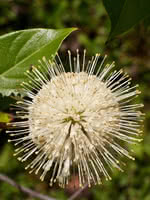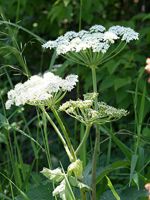Mon-Fri 9am - 5pm Mountain time
Buttonbush vs Cow Parsnip
Cephalanthus occidentalis
Heracleum maximum
CUSTOM GROW
CUSTOM GROW
Buttonbush is a moisture loving shrub that provides year round interest.
It has round, fragrant flowers resembling small buttons or pincushions. The flowers transform into small reddish-brown fruit that persists into winter while the leaves take on shades of red in fall.
Providing essential food to bees, butterflies, and other insects, this shrub is versatile. Try it in your next shrub border.
Cow Parsnip is a native perennial wildflower known for its tall growth, very large leaves, and broad clusters of white flowers. The abundant blossoms provide nectar and pollen for a wide variety of pollinators, including bees and butterflies. Birds and small mammals feed on its seeds, while the foliage serves as a larval host for certain butterfly species.
Cow Parsnip is often among the first native perennials to establish in disturbed or open sites. It typically grows in moist meadows, along streambanks, forest edges, and roadsides. Although usually a short-lived perennial or biennial, it readily self-seeds and maintains strong populations where conditions are favorable.
Cow Parsnip is the only native Heracleum in North America and should not be confused with the highly invasive Giant Hogweed (H. mantegazzianum).
Note: The sap of the Cow Parsnip can cause phytodermatitis when exposed to ultraviolet light (sunlight). This can cause rashes or even burns. Care should be taken if pruning or handling this plant.
Buttonbush Quick Facts
Cow Parsnip Quick Facts
Toxicity: sap causes skin irritation

